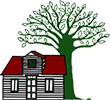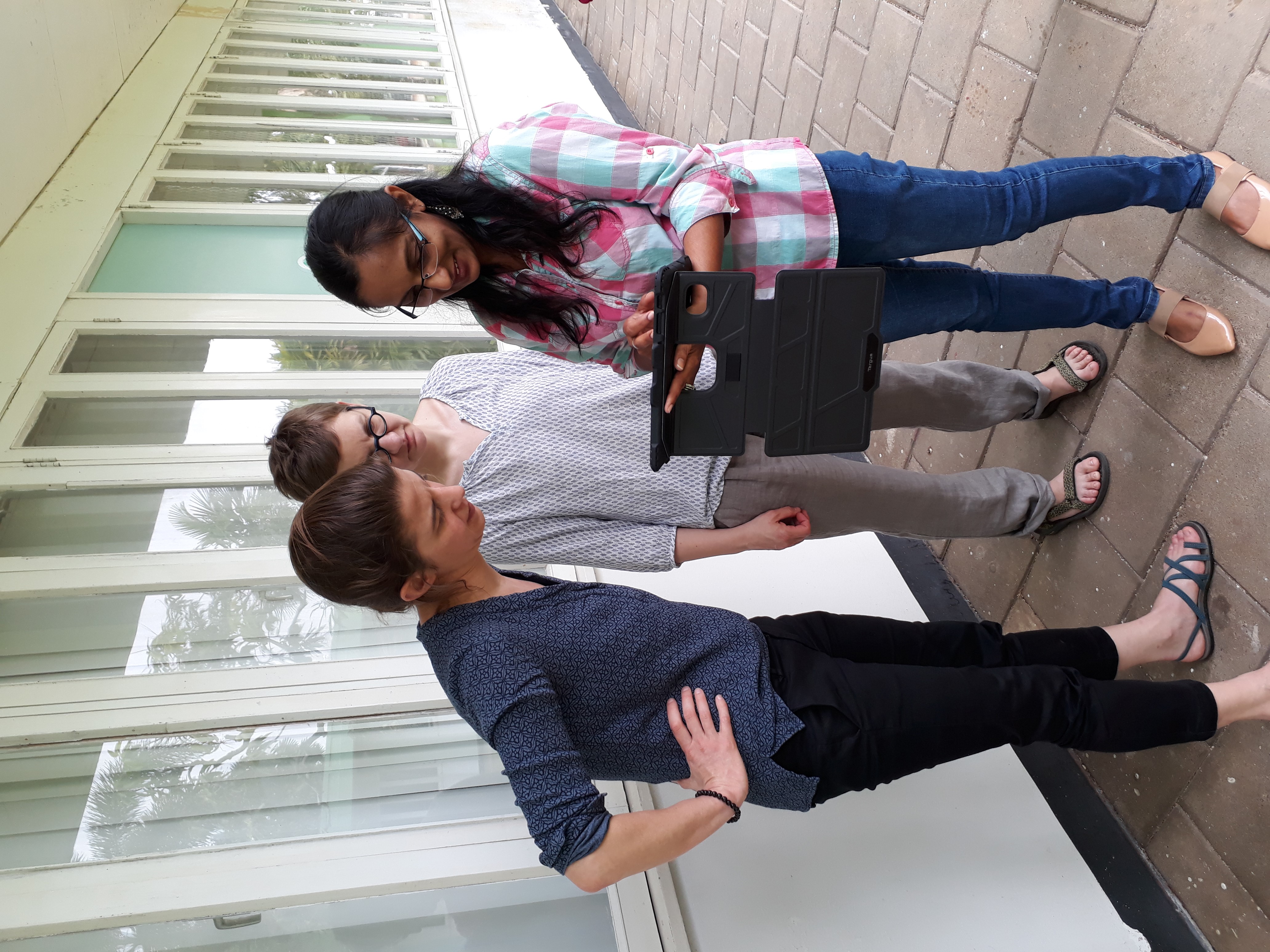Student Research
Within this project, students are busy completing their master's research.
The different research areas focus on mapping urban green areas in Paramaribo and the various ecosystem services they provide. In total there are five Master students who are doing their thesis research within the project. Supervision is provided in cooperation between Anton de Kom University Suriname, Twente University and Tropenbos Suriname.
- The spatial distribution and classification of urban greenery in Paramaribo, including a historical analysis of changes in this.
- The influence of the presence of urban greenery on the cooling of the immediate environment in neighborhoods and at street level.
- Quantification of the relationship between urban greenery and the micro-climate in Paramaribo in the form of a possible 'Urban Heat Island Effect'.
- Identifying, assessing and spatially mapping ecosystem services provided by urban greenery in Paramaribo.
- Paramaribo residents' perceptions of urban greenery and factors that may affect it.
- Urban Green in greater Paramaribo: Explorations of accessibility and social inequality.
- Mapping the quality of public urban green spaces for physical activity in Paramaribo, Suriname.
Analyzing Green Spaces in Paramaribo
and Developing a Method for Monitoring
using GIS and Remote Sensing
-Razia Taus (Anton de Kom University Suriname)-
Worldwide there is increasing scientific evidence about the benefits of urban green. However, relatively little is known about urban green in tropical areas. The first step is to find out what Urban Green is. In Paramaribo, the most urban area of Suriname, no accurate inventory and quantification of the green areas has been done yet. Where are these areas located? How big are they? Which vegetation types are most common? What are the possible effects they can have on their environment and the ecosystem in which they are located? In order to conduct proper research in these areas, it is important to make an assessment of the current state in which they are.
The main aim of this research is to develop a baseline of the current state of green areas within large Paramaribo and to analyze their spatial distribution.
Large Paramaribo was chosen as the study area. (Paramaribo, Wanica and part of Commewijne). Using satellite images, a GIS (Geographic Information System) program and field verification, a classification of urban green in Paramaribo is made. In this case, 8 classes can be distinguished: Water, built-up area, trees (forest fragments), mangroves, mixed lower vegetation, infrastructure, grass and bare soil. By analyzing how this has changed over time, information can be obtained about the effect of land use, such as the expansion of the urban area, which affect urban green areas.
Using this type of information, spatial planners and policymakers can make more effective use of space and better focus on sustainable urban planning, which takes into account the proven benefits of urban green for human well-being. Sentinel 2 satellite images have been downloaded for this area, which after processing have a resolution of 10 meters.
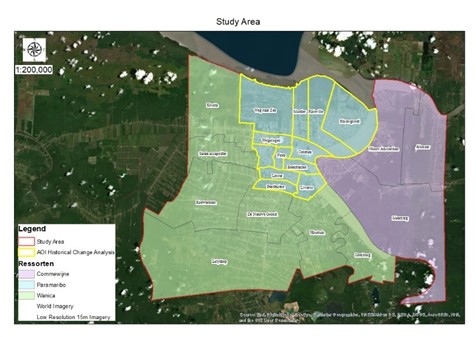
Razia her thesis can be found here
Towards a Greener and more Livable Paramaribo
The Cooling Effect of Urban Green Spaces
-Niel Kalpoe (Anton de Kom University Suriname)-
Urban green has a number of benefits for human well-being. One of the main ecosystem services of urban greenery is micro-climate regulation and reduction of the urban heat island effect (UHI). Regulation by green takes place during the evaporation process (evaporation), where sensible heat is consumed. This lowers the air temperature in the environment of green, the so-called micro-climate. With the expected rise in temperature, drought and intensity of heat waves due to climate change, the role of urban green will become even more important.
Urban green has a number of benefits for human well-being. One of the main ecosystem services of urban greenery is microclimate regulation and reduction of the urban heat island effect (UHI). Regulation by green takes place during the evaporation process (evaporation), where sensible heat is consumed. This lowers the air temperature in the environment of green, the so-called micro-climate. With the expected rise in temperature, drought and intensity of heat waves due to climate change, the role of urban green will become even more important.
The objectives of this research are:
- Quantifying the cooling effects of selected urban green areas in Paramaribo on adjacent residential areas.
- Analyze how different types of Urban Green Spaces (UGS) in Paramaribo and seasons influence the cooling of UGS.
- Comparison of climate-related observations in:
- UGS, such as in selected parks, and in heavily built-up areas, such as some residential areas in Paramaribo,
- Streets with trees and without trees.
Research of the benefits of different types of urban greenery on the micro-climate (air temperature and humidity) in Paramaribo, will make a substantial contribution to the science of micro-climate in tropical cities. Relevant data will also be collected and knowledge will be shared with policymakers, non-governmental organizations, project developers and citizens for better urban planning and policy.
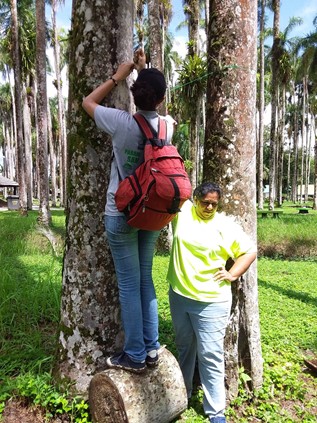
The Cooling Effect of
Urban Green Spaces in Paramaribo
-Tom Remijn (University of Amsterdam)-
The main aim of this study was to provide an analysis of the Urban Heat Island effect and of the cooling effect of urban green space in the whole rural-urban region of the tropical city of Paramaribo (Suriname) in both the wet and dry season.
The study was based upon a land cover map of the Greater Paramaribo Region and on land surface temperature, derived from Landsat 8 satellite data from both the wet and dry season. In order to study the effects of the composition (trees, mangroves, mixed low vegetation and grass) and configuration of urban green space on land surface temperatures, class metrics including percentage of landscape, aggregation index, landscape shape index, edge density and patch density were used. In addition, the influence of socioeconomic status on land surface temperature was tested. To complete the urban heat island study, air measurements were undertaken to allow for comparison between land surface and air temperatures across different land cover types.
The results show that a surface urban heat island effect exists between the urban core and the rural hinterland in Paramaribo. The magnitude was similar in both seasons (ca. 5.2 K). Urban green spaces were found to significantly mitigate this urban temperature increase. This cooling relationship was dependent on the urban green space type present. Trees and mangrove showed the strongest cooling effect on land surface temperature, while mixed low vegetation provided less, but still a significant, cooling effect. On the other hand, grass did not show a clear cooling relationship. Regardless of the type of urban green space, this study shows that increasing the size of urban green space increases the cooling effect.
Our results also show that a large aggregated urban green space is favored over a number of smaller dis-aggregated ones. The cooling effect of urban green space was slightly stronger in the dry season compared to the wet season. No relationship was found between the shape of urban green spaces and the land surface temperature in Paramaribo. The amount of urban green space was found to differ between neighborhoods with different socioeconomic status. This resulted in an indirect negative relationship between socioeconomic status and land surface temperature. This relationship did not apply to the neighborhoods of the lowest socioeconomic status, since due to the sandy characteristic of the streets in these neighborhoods, their land surface temperature was also low.
Based on these results, it is concluded that there is a substantial urban heat island present in Paramaribo in both the wet and the dry season. In addition, this study also shows that urban green space could provide a nature-based solution to mitigate this urban heat island in Paramaribo. Due to the lack of studies on urban ecosystem services in the global South, this study in Paramaribo can potentially add to the valuation of urban green spaces in policy across cities in the global South.
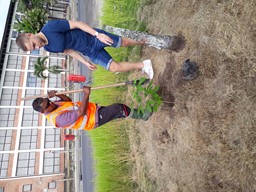
Tom his thesis is published on the website of Universiteit van Amsterdam.
Current and Future Supply of Ecosystem Services
derived from Urban Green Spaces in
the Tropical City of Paramaribo
-Joe McMeekin (University of Amsterdam)-
Objectives:
- To quantify and map the current supply of key ecosystem services derived from green space in Greater Paramaribo.
- To develop three plausible future scenarios in which urban expansion and land use change, and therefore changes in green space, are estimated and visualized for the year 2035.
- To analyze how the identified scenarios would affect future ecosystem service supply derived from green spaces in Greater Paramaribo.
Approximately 55% of the current global population of 7.7 billion people reside in urban areas. These urban areas are expected to absorb almost all of the projected future population growth and consequentially an extra 2.4 billion people are expected to live in urban areas by 2050. Sustainable management of cities and urban expansion has therefore never been more relevant than it is today and research focusing on urban environments is of vital importance in order to improve understanding of urban dynamics and to facilitate sustainable management practices.
Urbanization and urban expansion result in extensive land use change on a global scale, and this land transformation has a number of associated impacts for the local environment and local communities. One common effect is a reduction in the amount of green spaces, such as trees, grass and shrubs within urban areas. This in turn leads to a reduction in societal benefits associated with these green spaces which has potential to inhibit sustainable development and can introduce or enhance certain challenges residents and authorities face in urban environments. The proposed research will focus on such benefits by investigating the current and future supply of ecosystem services derived from green space in the tropical South American city of Paramaribo in Suriname.
The ecosystem services considered within this study will be carbon storage, coastal protection, recreation, flood protection and local climate regulation, all of which have been deemed to be relevant for the city of Paramaribo. InVEST (Integrated Valuation of Ecosystem Services and Tradeoffs) modelling software will be used to model and map the current supply of these ecosystem services in the Greater Paramaribo region. Future scenarios for land use change resulting from urban expansion by 2035 will then be defined and modeled using the CLUE (the Conversion of Land Use and its Effects) modelling framework.
These scenarios will be developed according to current development plans and initiatives, available literature and consultation with stakeholders. They will allow for quantification of potential future supply of the considered urban ecosystem services, and analysis on the differences between current and future supply will enable potential synergies and trade-offs to be identified for each of the different scenarios. Research quantifying current and future ecosystem services derived from green space is relatively common for temperate regions of the planet, particularly in the global north. However, there has been little research focusing on this in either tropical or South American cities such as Paramaribo. The research, conducted as part of the “Towards a green and more livable Paramaribo” twinning project, therefore aims to contribute to the widening of scientific understanding on ecosystem services and the role of green space in urban environments in diverse geographic settings.
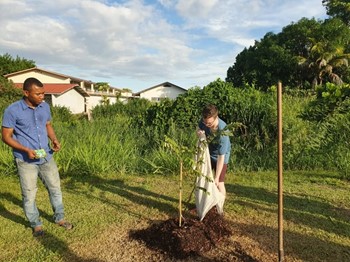
Joe his thesis is published on the website of the Universiteit van Amsterdam.
Urban Green Spaces in Paramaribo:
Perception, Use and Management of
Urban Green Spaces
-Saskia Chote (Anton de Kom University Suriname)-
In tropical cities, such as Paramaribo, relatively little research has been done into urban greenery and its benefits. Lifestyle, culture, socio-economic status and demography all play a role in how people view urban greenery. It is necessary to have a better understanding of the perceptions that residents of Paramaribo have about urban green and the ecosystem services they provide, as well as what contributing factors underlie these perceptions. This can help shift public opinion about urban green in favor of improved urban policies when it comes to green spaces.
The aim of this research is to identify and analyze perceptions and use of city dwellers regarding urban greenery in Paramaribo. It also examines which factors influence these perceptions and the use of urban greenery. This gives us more insight into what people think about greenery in their environment and what their needs are when it comes to public green spaces. The aim is also to identify the ecosystem services of these green spaces and to analyze the management of these spaces. The information from this research can also be used by policy makers to formulate their green policy or to draw up a green management plan. During this research, perceptions of city dwellers and the current management structure of the areas are examined using surveys, interviews and observations.
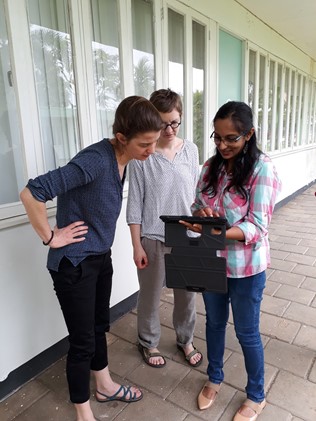
Saskia her thesis could be found here
Urban Green in greater Paramaribo:
Explorations of accessibility and social inequality
-Bernice Osei Buohemaa (University of Twente)-
Urbanization has resulted in an increase in the population of people living in cities across the world. This has led to many negative effects in the urban cities such as loss of urban natural areas and a rise in local temperatures etc. These negative effects can be mitigated with the help of urban green spaces (UGS) which helps make cities sustainable and more pleasant places to live. With the many benefits of UGS such as reducing temperature and air quality regulation, and providing a place for social cohesion and recreation, there is the need for access for all. This led to research into EXPLORATIONS OF ACCESSIBILITY AND SOCIAL INEQUALITY OF URBAN GREEN IN GREATER PARAMARIBO. The research objectives specifically looked to:
1: Investigate the spatial distribution of green spaces in the Greater Paramaribo Region.
2: Assess the level of accessibility to green spaces in the Greater Paramaribo Region.
3: Assess the level of social inequality associated with the accessibility to UGS in the Greater Paramaribo Region.
This study classified the types of UGS using a visual interpretation based on aerial images and then analyzed the distribution of the UGS types in Greater Paramaribo. Using network analysis, the accessibility to UGS was then analyzed using the sizes of UGS and different modes of transportation. To assess the level of social inequality this research used the Gini coefficient and the Pearson correlation.
The results obtained from the research showed that there are more UGS in the outskirts of the region than in the central parts. However, there is more variation in the types of UGS in the central parts of the Greater Paramaribo Region than in the outskirts since UGS types such as playgrounds are mostly concentrated in the central parts. Results also indicate that those resorts with the highest access to UGS are the ones outside the center, where many Javanese and Hindustani live. On the contrary, Creoles and Natives more frequently live in central resorts with least access to UGS . Compared to the average residential house, elderly homes and schools in the Greater Paramaribo Region have better access to UGS; and average income per resort is not correlated with accessibility. It is recommended to increase UGS availability and diversity of UGS types in disadvantaged resorts especially within walking distance of residential houses so that all residents can benefit from UGS.
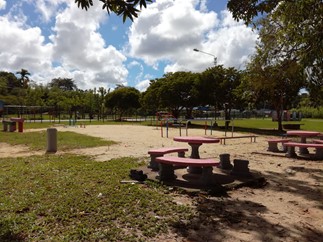
Play and sports equipment in the Cultuurtuin near the Paramaribo zoo
Bernice her thesis is published on the website of the Universiteit van Twente.
Mapping the quality of public urban green spaces
for physical activity in Paramaribo, Suriname
-Druti Gangwar (University of Twente)-
Cities are growing demographically and economically leading to high work pressures on urban residents. Longer indoor working hours reduce outdoor recreational time thereby threaten their health and well-being. SDG 11.7 highlights the importance of “providing universal access to safe, inclusive and accessible, green and public spaces”. The COVID-19 pandemic has re-emphasized the importance of physical activities in maintaining a healthy lifestyle. Urban green spaces are providers of opportunities for outdoor physical activity.
Paramaribo has seen uncontrolled urban growth in recent decades, and it has come at the cost of trees, and urban forests leaving the city with fragments of forest and green cover. This is further worsened due to a lack of knowledge on the benefits of public urban green and improper management of urban green spaces. This study aimed to assess the ‘quality’ of public urban green spaces in Paramaribo and their relationship with the physical activities of all public urban green spaces in Paramaribo. The two objectives of this study were,
- To map the spatial distribution of quality characteristics for all public urban green spaces in Paramaribo
- To identify the relationship between quality characteristics and physical activity in all public urban green spaces of Paramaribo
A total of 30 locations were identified as ‘All Public urban green spaces’ for which measurements were derived from online spatial data and social media data. These 30 public urban green spaces include five locations being monitored under the Groen Paramaribo Project. This research used geo-spatial tools to map the quality characteristics of public urban green spaces in Paramaribo and statistically model their relationship with physical activity.
Results for the first objective show that the quality characteristics such as spaciousness, greenness, and quietness were higher for locations in the Paramaribo’s outskirts, while accessibility to the public urban green spaces locations is higher the residential areas. The survey/field data measurements showed that quality characteristics like safety, cleanliness, and facilities are essential to understanding the overall quality of a public urban green space. The study was able to confirm that citizen gathered data on condition and uses of public urban green spaces provides valuable insights to quality of public urban green spaces. Findings for the second objective show that spaciousness and accessibility to a public urban green space are related to physical activity. But the statistical outputs also suggest that the quality characteristics used to build the model are an underestimation of the likelihood meaning there may be other factors to predict physical activity.
This study indicates that there may be other factors that could have a potential influence on the relation between quality and physical activity. A few suspected factors include surrounding land use of public urban green spaces, urban flooding, and the urban heat island effect in Paramaribo. This study also elaborates on the challenges and further recommendations for studying the ‘quality’ of public urban green spaces. In the end, the implication of this study for the urban management of public urban green space in Paramaribo is also described.
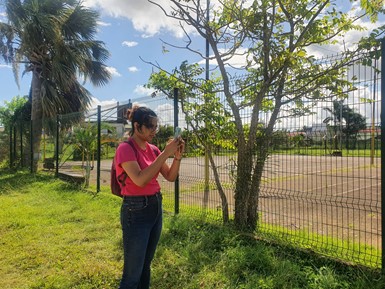
Druti her thesis is published on the website of the Universiteit van Twente.
